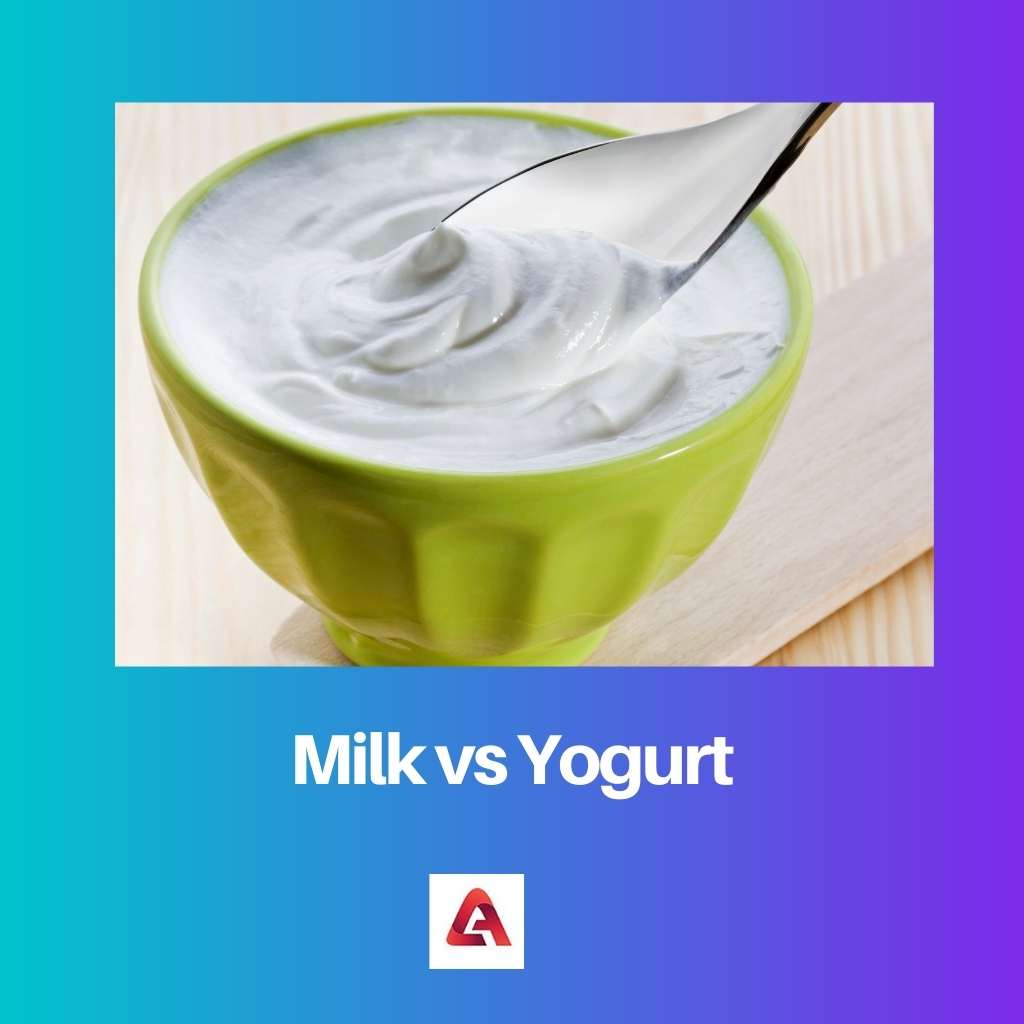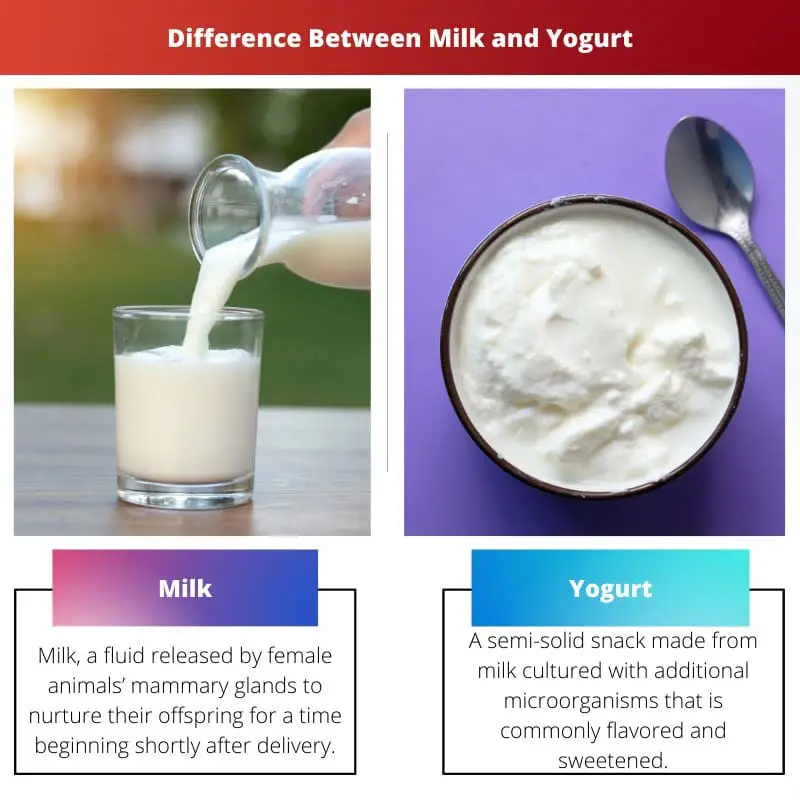There are wide different varieties of yoghurt and milk, such as low-fat and low-fat yoghurt. However, milk is only one of the numerous elements contained in yoghurt. It is relatively straightforward to distinguish between milk and yoghurt.
However, this essay will explain the distinctions between the two dietary substances to dispel misconceptions about Milk and Yogurt.
Key Takeaways
- Milk is a liquid dairy product, while yogurt is a fermented dairy product.
- Yogurt contains more protein and less lactose than milk.
- Yogurt has various probiotic bacteria that are more beneficial for gut health than milk.
Milk vs Yogurt
The difference between milk and yoghurt is that milk is more liquid, but yoghurt is much denser. Milk and yoghurt have glycemic indices of 36 as well as 38, indicating that they are both low in glycemic load.
Carbohydrates are absorbed slowly into the digestive tract, preventing insulin surges.

Milk is a fluid released by female animals’ mammary glands to nurture their offspring for a time beginning shortly after delivery. Domestic animal milking is also an essential food supply for humanity, either as a pure fluid or as a variety of milk products like butter, cream, and cheese.
Yoghurt is a dairy product made by the fermenting of milk by certain microbes, which must be alive, functional, and numerous in the production of Lactobacillus and Streptococcus thermophilus. Producers have contributed to the increase in yoghurt intake by producing various yoghurt kinds, such as Greek yoghurt, low-fat and no-fat yoghurt, creamy, sipping, bio-yoghurt, chilled, and so on.
On the other hand, the fundamental components and production are essentially coherent.
Comparison Table
| Parameters of Comparison | Milk | Milk a fluid released by female animals’ mammary glands to nurture their offspring for a time beginning shortly after delivery. |
|---|---|---|
| Meaning | A semi-solid snack made from milk cultured with additional microorganisms that are commonly flavored and sweetened. | It is a complex food and requires many processes to break down into glucose and galactose completely. |
| Digestion | It is straightforward to digest and is prescribed when facing digestive issues. | Homogenized, pasteurized, skimmed, whole-milk, toned, etc., are some types of milks. |
| Types | Kefir, low-fat, No-fat, frozen yoghurt, non-dairy yogurt, flavored fruit yogurt, etc. | For whole consumption and for manufacturing dairy products like cheese, butter, curd and yogurt. |
| Use | A semi-solid snack made from milk cultured with additional microorganisms that are commonly flavoured and sweetened. | Protein, fat, vitamin D, B12, Riboflavin, Potassium, etc. |
| Nutrition | Water, protein, carbohydrates and vitamins D and C. | Water, protein, carbohydrates and vitamin D and C. |
What is Milk?
Milk is a vibrant and nutritional white-yellowish fluid secreted from animals’ mammary glands. It serves as the principal source of nourishment for young animals (mainly breastfed human newborns) before they can even digest regular food.
Milk is also called a ‘complete food’ for children as it acts as a balanced nutrient supply for a child’s body. For a long period after conception, each species’ milk appears to provide a whole food source for its offspring.
Milk is transformed in the intestines of the young to a soft curd which completely covers globules of fat, allowing digestion to continue easily without the disruption produced by fatty meals. Most of the milk consumption in Western nations now comes from cows, and milk products are becoming essential commodities.
Additional primary milk sources include goats and sheep, which seem to be particularly important in southern Europe and the Mediterranean region; water buffalo, which are widely tamed in Asia; and camels, which are essential in the Mideast. Milk is an emulsified fat and protein in fluid, including absorbed sugar (carbohydrate), vitamins, and nutrients.
All animals’ milk contains these elements. However, their quantities vary across species and within species.

| # | Preview | Product | |
|---|---|---|---|
| 1 |

| Maple Hill Creamery Organic Whole Milk, 64 fz | Check Price on Amazon |
| 2 |

| PET Dairy Whole Milk with Vitamin D, Milk Half Gallon - 1 Jug | Check Price on Amazon |
What is Yogurt?
Yogurt is an ancient food. The earliest signs of it were discovered between 10 000 and 5 000 BCE during the Neolithic times, while nomadic tribes were adapting to a different way of living, and the origins of agriculture gradually led to a permanent existence.
At the same time, people were beginning to domesticate milk-producing animals, including cows, goats, bison, yaks, and horses. Yoghurt, like milk, comes in various flavours, such as fat-free yoghurt, and flavoured yoghurt.
Flavoured Curd can be consumed with or without food. Yoghurt, with its different depth of flavour, is easier to digest than milk and keeps you fuller for longer.
Yoghurt, which is high in probiotics, can aid in cleansing the digestive tract. An ounce of Greek yoghurt has around 12 g of protein.
According to the USDA, you’ll be surprised to learn that 100 g of yoghurt includes 106 milligrams of calcium. Regular yoghurt has 16 to 17 grams of carbs, and Greek yoghurt contains 8 to 9 grams.
Lactose levels in yoghurt are lower than in whole milk. While this may not be true in all circumstances since certain yoghurt manufacturers create specific yoghurt formulae with a higher lactose content, most yoghurts have lost much of their lactose since it was converted into glucose and galactose.
That is one of the explanations why yoghurt is such an easy food to digest. This means that even lactose-intolerant people are less likely to get gastric or stomach troubles.

| # | Preview | Product | |
|---|---|---|---|
| 1 |

| FAGE Total Greek Yogurt, 0% Nonfat, Plain, 32 oz | Check Price on Amazon |
| 2 |

| Chobani® Non-Fat Plain Greek Yogurt 32oz | Check Price on Amazon |
Main Differences Between Milk and Yogurt
- Milk is fluidic, whereas yoghurt is semi-solid and jiggly in texture.
- Milk is watery and yellowish-white in colour and mixes uniformly with water whereas curd forms colloid when mixed with water and it is pure crystal white in colour.
- Milk requires a complex digestion process, whereas yogurt can be digested easily.
- Milk is nutritional food whereas yoghurt is simply more enriched and beneficial than milk hence, it is preferred when patients go through digestive problems.
- Milk can be used to make yogurt, but yogurt cannot be converted back to milk.


The comparison table is a useful and succinct summary of the main differences between milk and yogurt. However, more coverage of how people from different parts of the world use milk and yogurt as part of their daily diet would be a good addition. It would be interesting to know how this affects the health and nutrition of those populations. Looking forward to reading more of your articles.
While I commend the explanations and comparisons provided in the article, I believe that a closer look at the ethical considerations associated with milk production and the wider impact of dairy farming on animal welfare and the environment would have added depth to the discussion. It would have brought a more balanced view of milk consumption. Perhaps that can be explored in your future articles.
An insightful article that adeptly highlights the differences in the nutritional content between milk and yogurt. The information is rich and comprehensive, addressing various aspects of the two dairy products. Your comparison does justice in debunking misconceptions and clearing the air about milk and yogurt. Great job! Really appreciate the research and analysis that went into this.
Another great piece. It’s a good practice to highlight the differences between popular food products. Your descriptions of the two dietary products, the nutrition value, the digestive process, and the historical development in the consumption of milk and yogurt are concise but enlightening. I wished you could have included an overview of the potential health risks in milk and yogurt consumption though.
It’s great to see a detailed examination of milk and yogurt, providing a comprehensive understanding of their roles as dietary staples. Though I would encourage you to delve deeper into the environmental implications of consuming large quantities of milk and yogurt. The environmental perspective would make the comparison more well-rounded and reflect the broader implications of our dietary choices.
The information about the history and evolution of milk and yogurt consumption is fascinating. However, the inclusion of the recent developments and future trends in the milk and yogurt industry would be relevant considering the rapid innovations in food technology and production. It always pays to consider the future impact of the dietary choices we make today. Keep up the excellent work.